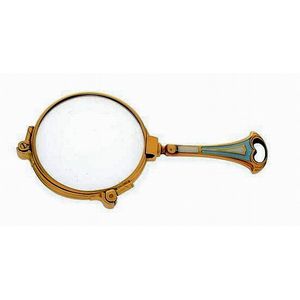Edwardian Mahogany Toilet Mirror with Georgian Revival Design
An Edwardian mahogany toilet mirror, early 20th century, a Georgian revival mirror with an oval framed glass and elegant scrolling supports above a serpentine base comprising three small drawers with barber's pole stringing, raised on petite bracket feet, height 65 cm, width 48 cm, depth 20 cm
You must be a subscriber, and be logged in to view price and dealer details.
Subscribe Now to view actual auction price for this item
When you subscribe, you have the option of setting the currency in which to display prices to $Au, $US, $NZ or Stg.
This item has been sold, and the description, image and price are for reference purposes only.
- Edwardian - The Edwardian period of English furniture and decorative arts design is named for Edward VII (1841 ? 1910) who was King of the United Kingdom and the British Dominions and Emperor of India for the brief period from 1901 until his death in 1910. It follows the Victorian period, in turn was followed by the Art Nouveau and Art Deco styles. In Australia, designs of this period are also known as being in the Federation style.
- Serpentine - Resembling a serpent, in the form of an elongated 'S'. A serpentine front is similar to a bow front, except that the curve is shallow at each end, swelling towards the middle. The term presumably derives from its similarity to a moving snake or serpent. Serpentine fronts are usually veneered, with the carcase either being cut and shaped from a solid piece of timber, or built in the 'brick' method.
- Bracket Feet - On bracket feet the corner edge is square and joined by a mitre to its partner on the opposite angle. The inner edge is usually shaped or scalloped. Bracket feet were first introduced in the early 18th century and used until c. 1830 and are found on carcase furniture such as chests, cabinets, bookcases and bureaux.
Ogee bracket feet, a variation on straight bracket feet, have the outside edge forming an "S" shaped curve with the top bulging outward and the bottom turning inward.
On splayed bracket feet, the exterior edge curves outward. - Stringing - Fine inlaid lines, in contrasting colour to the carcase timber, found mainly on furniture made in the styles of the later 18th and early 19th centuries. Stringing, which may be of satinwood, pine, ebony, horn, brass or occasionally ivory, is found principally on drawer fronts, around the outer edges of usually tapered legs and French bracket feet, around the edges of inlaid panels and between the joint of the cross banding and carcase timber on table tops, chests of drawers, cabinets etc. The effect is to emphasize the line of the piece and add to the impression of lightness and elegance. Stringing also occurs in Sheraton-revival-style furniture of the later 19th and early 20th centuries.
- Mahogany - Mahogany is a dense, close grained red-coloured timber from the West Indies and Central America. It was first imported into Europe in the the early 18th century and its use continued through the 19th century. It was popular for furniture making because of its strength, the wide boards available, the distinctive grain on some boards, termed flame mahogany and the rich warm colour of the timber when it was polished.. The "flame" was produced where a limb grew out from the trunk of the tree, and this timber was usually sliced into veneers for feature panels on doors, backs and cornices.
Some terms used to describe mahogany relate to the country from which it originally came, such as "Cuban" mahogany, "Honduras" mahogany etc. However unless the wood has been tested the names assigned are more a selling feature, rather than a true indication of the timber's origin. - Georgian - As an English stylistic period, Georgian is usually taken to cover the period from George I (1714) to the Regency of Prince George (1811-20), although the period from 1800 to 1830 is sometimes designated as the Regency period. During the Georgian period the great English cabinetmakers and designers such as Chippendale, Hepplewhite, Adam Sheraton etc., were all active.
Therefore there isn't a single 'Georgian style' as such and to say something is 'Georgian', usually means it was made between 1714 and 1830. This assumes we discount George V and George VI, both being from the 20th century.
The styles popular at the time of each reign were:
George I (1714-1727) saw out the last years of the Baroque period.
George II (1727-1760) reigned during the Rococo period.
George III (1760-1820) saw the last gasp of the Rococo, all of the early Neo-Classic 'Adam style' and most of the later neo-Classic 'Regency style'.
George IV (Prince Regent 1820-1830)encompassed the last of the 'Regency' style.
William IV's reign (1830-1837) was something of a no man's land (stylistically) and he wasn't a 'George' anyway. He covered the last glimmerings of 'Regency' and the start of the 'Victorian' style.
This item has been included into following indexes:
Visually similar items

A mahogany dressing mirror, mid to late Victorian, oval mirror of large proportions, on fluted column stand, height 180 cm
Sold by
in
for
You can display prices in $Au, $US, $NZ or Stg.

A fancy gold bangle, the hollow oval bangle with hinged sections, in two tone 18ct gold.
Sold by
in
for
You can display prices in $Au, $US, $NZ or Stg.

An Art Nouveau lorgnette, the 14ct gold frame with guilloche enamel handle
Sold by
in
for
You can display prices in $Au, $US, $NZ or Stg.

Vintage cast iron leg irons, length 67 cm approx
Sold by
in
for
You can display prices in $Au, $US, $NZ or Stg.
